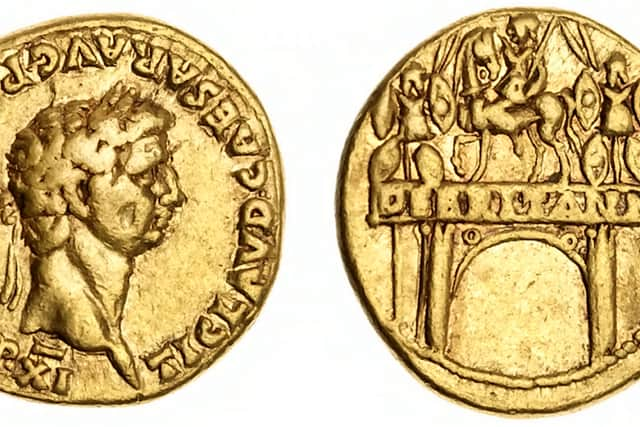Roman coin plucked from the ashes of Pompeii eruption sells at auction for £18,000
and live on Freeview channel 276
A perfectly-preserved Roman coin celebrating Emperor Claudius’s conquest of Britain has sold at auction for £18,000 after being discovered from the ashes of Pompeii. The gold aureus celebrating the conquest in AD 43 was uncovered among the ruins of a suburb five kilometres north of the archaeological site in southern Italy’s Campania region.
Experts say they are hardly surprised the coin, born from two of the most dramatic events of the Ancient World, fetched such an eye-watering price at auction. The “breathtaking” history of the small coin saw it contested over by collectors and museums across Europe.
Advertisement
Hide AdAdvertisement
Hide AdIt is made all the more valuable due to treasure-hunting now being strictly prohibited in the UNESCO-protected areas surrounding Pompeii. The coin was first found by antiquarians in 1895, beneath mounds of volcanic ash inside the Roman villa ravaged and preserved by the eruption of the volcano Vesuvius in 79 AD.
The eruption is still regarded as the most high-profile in history due to the ash preserving the ruins and the lives of the people there. The eruption of Vesuvius in 79 AD killed more than 16,000 residents of the city and its surrounding environs, including the smaller town of Herculaneum and other towns and villages in the region on the Amalfi coast.
The coin was discovered as part of a horde alongside the body of a servant in the wine-pressing room of the Villa della Pisanella in the suburbs of the town of Boscoréale. The unimaginable volcanic temperatures of the eruption toned the coin with a distinctive reddish hue.
But, this particular coin was buried deep enough under the ash that it preserved its golden glow. From the position of the human remains found near the horde, alongside silver tableware inscribed to the lady of the house, Maxima, it was determined that the unidentified man perished while dutifully guarding the treasures.
Advertisement
Hide AdAdvertisement
Hide AdThe coin is estimated to have been worth the equivalent of around six to eight weeks’ wages for the average Roman soldier. One face of the coin depicts the triumphal arch of Claudius on the Via Flaminia road out of Rome, topped by an equestrian statue of Emperor Claudius flanked by British battle shields and inscribed DE [VICTIS] BRITANN[IS] - ‘Triumph over the Britons’.


Emperor Claudius launched the Roman conquest of Britain in AD 43, which was largely completed in the southern half of Britain by AD 87. Roman historians record Claudius as receiving the surrender of 11 British tribal chieftains.
The first recorded sale of the coin came in 1898 when, ironically, the coin celebrating British defeat at the hands of Romans was bought by Englishman Sir Samuel Bagster Boulton, a vice chairman of the London Chamber of Commerce. The coin was passed down through generations of the Boulton family through Sir Samuel’s children - one of whom survived the sinking of the RMS Lusitania in May 1915.
The family sold their collection of Boscoréale coins in 1942 to London coin dealers Spink, and the coin in question was sold for £12 (around £450 today) to the present vendor’s family, where it has remained ever since. But the coin was finally sold at another Spink auction for the first time in more than 80 years to a private collector, for the price of £18,000.
Advertisement
Hide AdAdvertisement
Hide AdOn the cultural and historical significance of the coin, Gregory Edmund, the Roman Coin advisor at Spink, said: "If you were to combine the two most dramatic events of the Ancient World into one object, this would be the dream combination.
“While its discovery is hardly bathed in the rigorous archaeological disciplines we would demand today, and have since rightfully legislated the world over to enshrine, the pure theatrical romance of finding Roman gold leaves little to anyone’s imagination.
